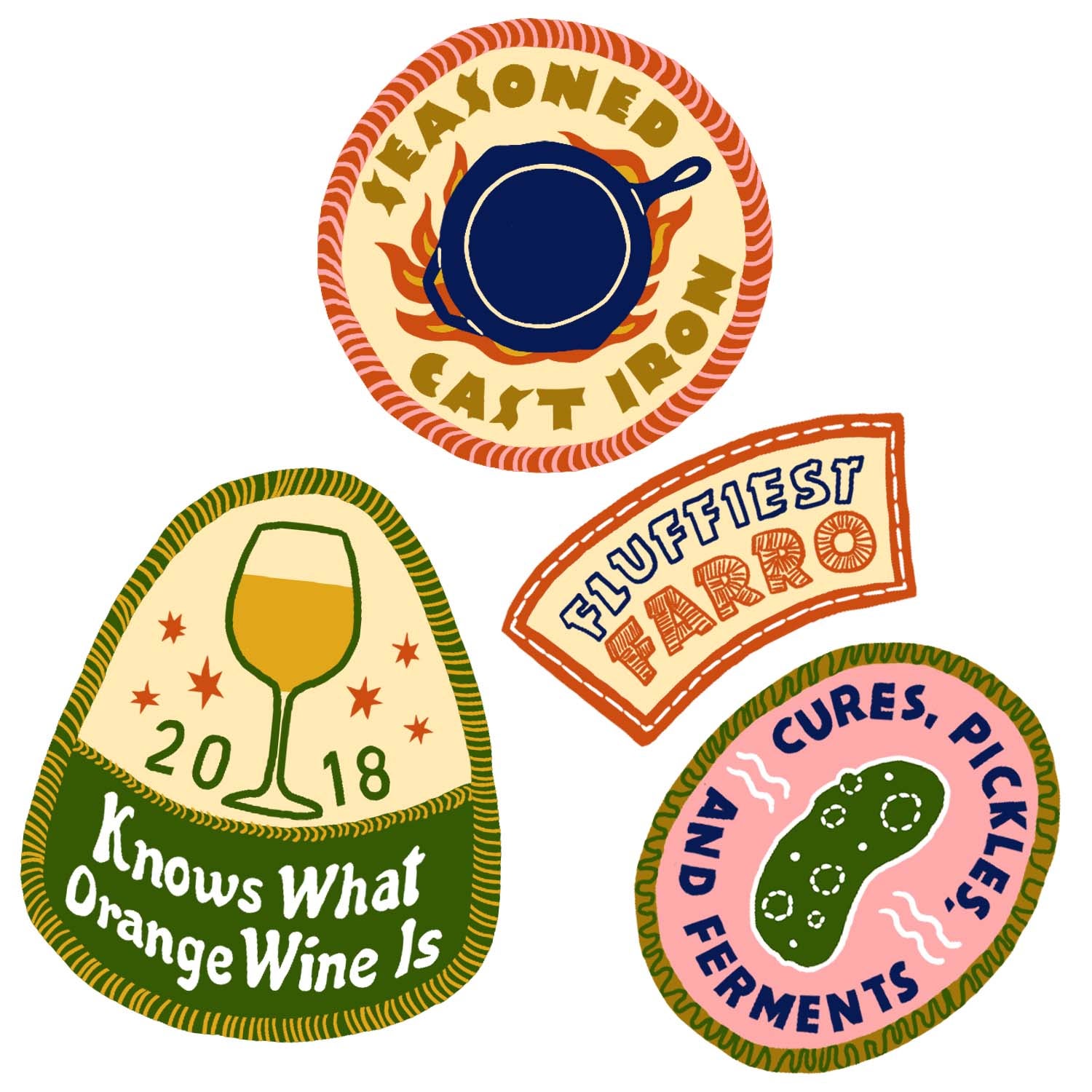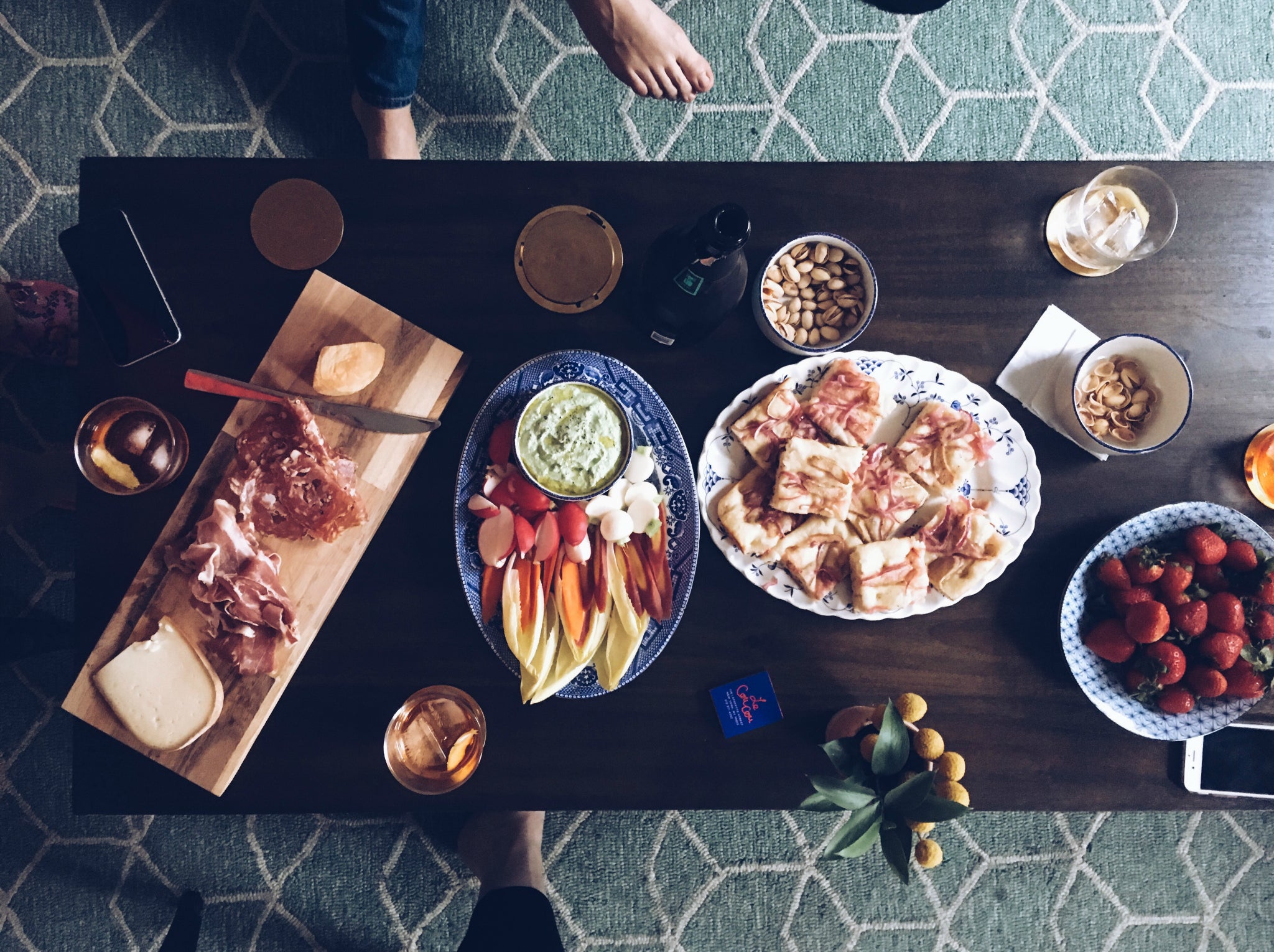
What motivates the youngest generation of home cooks? A writer of a certain age sets out to decode the dinner party flex.
Once upon a time, I’d fire up Instagram and scroll through to see what my friends were doing. I was broke, but we all were, so most of our doings took place in sweat-stained basement bars and scarcely furnished walkup apartments. We rarely posted pictures of food—most of our disposable income went toward bodega beers, and the stuff we did eat wasn’t worth memorializing anyway.
That was in 2010, the year Instagram launched. I was one year out of college and living in New York. Nearly a decade later, I’m still here, and so is Instagram (and Facebook, and Snapchat, and Twitter, and so on), but what I see when I look at my feed has changed dramatically. As I settle into my 30s, my friends—both older and younger by a decade—aren’t posting about last night’s party, unless it was a dinner one. Or maybe it’s not even a party at all, but a perfectly plated meal of herb-strewn ancient grains and heritage-breed braised chicken for two that wouldn’t look out of place on the communal tables at Ottolenghi.
I realize that cooking at home is not exactly revolutionary. But arranging the plate of farro salad just so, snapping a photo in natural light (obviously), and broadcasting it to your approximately 5,695 friends on social media? That feels new. The more I scrolled through a feed filled with roasted rainbow carrots and artfully mistmatched vintage cutlery, the more I suspected that posting about home cooking had become, for a certain content-savvy demographic that’s entering adulthood, a status symbol. Nothing says “I’m a grown-up” like putting a proper meal on the table, and posting about it is a way of announcing that you are in a time and place in life where you have the time, money, and inclination to do so. Or so I thought.
I’ve been nursing this pet theory for a while now, collecting anecdotal evidence while falling down Instagram K-holes and holding conversations at, yes, dinner parties of my own design. And it’s worth noting that since I write about food for a living, many of the people on my feed are great cooks or otherwise very into food for work and play. But an interesting thing began to happen as I looked for harder proof, interviewing non-food people their 20s and 30s who post frequently about home cooking and collecting data to attempt to back it up. Yes, my peers are bragging about home cooking on social media, but their motivations are largely not about performing some rite of adulthood or aspiring to show off a hashtag-blessed lifestyle. In fact, what I heard has largely restored my faith in home cooking as an act rooted in the desire for honest-to-God human connection.
First, I looked for data that would help me understand more about millennial shopping habits. A recent Harris Poll survey found that 70 percent of 18- to 34-year-olds commit only about 35 percent of their total food and beverage spending to grocery stores, but a closer look at the data reveals that it’s not as simple as opting for a restaurant over a supermarket. “Channel definitions are blurring, and a bevy of new options are combining the roles of the restaurant, grocer, farmer and concierge,” wrote Neilsen in its 2018 report. In other words, the kids these days are cooking at home, but they’re shopping outside of traditional supermarkets, opting instead for newfangled hybrid food shops and services that offer a more bespoke-feeling shopping experience.
Meanwhile, FMI reports that 73 percent of millennials plan, shop, and “explore food culture” through social media, and 78 percent of grocery retailers have social media programs they use to engage customers. I don’t think it’s a stretch to suggest that these converging behaviors, combined with the overwhelming amount of digital cooking content available, has encouraged younger audiences to both cook and post about it more frequently.
Data aside, in order to understand what I’ve come to refer to as “flexing about home cooking,” I wanted to understand more about why my young adult peers cook to begin with. The answers ranged from cost effectiveness to creative outlet to ability-enhancing exercise. Everyone I interviewed expressed pride in their home-cooking abilities and a desire to share it with friends.
Audrey Schield, a 22-year-old recent college graduate working in advertising in Chicago, told me that cooking with her friends is a way of socializing that doesn’t revolve around “doing homework or drinking”—two group activities that defined the majority of her social life in college. She cooks for friends several times a month, often before they head out to bars for the night.
Samantha Garfield, a brand impact strategist in New York, who at 30 is older than Schield, enjoys a level of personal and professional independence that makes cooking feel special. “It’s a way to treat myself and my friends and show off something that I’m good at,” she says. Garfield is comfortable spending on higher-end ingredients like free-range meat and organic farmers’ market produce and says that investment “makes me more excited to get home and cook.” Garfield notes that she’s currently able to enjoy both relative financial freedom and a lack of domestic obligations (she does not have a spouse, child, or mortgage) but recognizes that likely won’t always be the case. “Cooking is a pleasure for me, because at my stage I don’t have to do it for anyone else,” she says. “I know I won’t always be able to spontaneously get four friends to my house on a random weeknight in the future, when our lifestyles are less flexible.”
“I’m profoundly noncynical about the act of bragging about things I’ve made on Instagram.”
Alanna Bass, 29, who works at a startup, recently relocated from Atlanta to New York and likes the “intimate experience” you get cooking with friends rather than going out. “It’s a different way of connecting than when you’re out,” she says. “You see a different side of your friends at home. It’s more comfortable, and you can save money.” She often uses it as an occasion to re-create restaurant dishes she sees online. Plus, it’s practical: “It’s nice knowing that if you eat or drink too much, you can just go to the couch and pass out,” she says.
I specifically sought out sources who actively posted about their home-cooking adventures on social media. When I asked why they posted, the answers were more thoughtful than the stereotype of navel-gazing millennials might suggest. Maybe I just so happened to talk to a handful of particularly articulate 22- to 37-year-olds. Or maybe flexing about home cooking is a more meaningful activity than I initially suspected.
“I’m profoundly noncynical about the act of bragging about things I’ve made on Instagram,” says Nozlee Samadzadeh, 30, an engineer in New York who also kept a blog of nearly everything she ate from 2009 to 2015. “Yes, it’s a performance, but I think it can be a really productive one. The act of making something and sharing it is inherently sincere. I think it’s pretty cool to create something with my own hands, and I don’t feel bad about performing that for a community of friends,” she says. Samadzadeh talks about posting her meals as a way to both document the fruits of her labor and as a catalyst for self-reflection. “I’ve been making things for as long as I can remember, and the act of recording them and sharing them has helped me understand why I create to begin with,” she says.
Unlike much of the ultra-aspirational content that floods social feeds (#vanlife, anyone?), sharing cooking-related posts feels more intimate and less idealized. Several people mentioned posting about cooking on Instagram Stories or Snapchat (both of which disappear after 24 hours) as a way to showcase their more mundane going-ons. “Snapchat is all about personalized one-to-one communications, so you feel like you can let someone in on more everyday moments,” says Schield, who sends friends and family step-by-step videos of what she’s cooking at home. “Instagram and Facebook are the ideal me, whereas Snapchat is the real me.” Some have cut back on their food-related posts as they get older: “I actually post less about food than I used to—I think it’s because the more confident I feel in my success personally, the less inclined I am to share it publicly,” Garfield says.
In talking to my fellow young adults, I realized that flexing about home cooking, perhaps more than any other type of flexing, is actually an honest reflection of inner lives. “A lot of content is made for entertainment,” says Schield. “I try to post things that foster connection—that’s what cooking is all about.” And Samadzadeh is quick to point out that her food posts aren’t always glamorous: “I’ve posted everything from a hilariously depressing PB&J to a giant Sichuan meal I made from scratch,” she says. And at the end of the day, adds Bass, the flex is not always a priority. “I make some really great stuff, but I don’t always post about it—honestly, sometimes I just want to eat it.”

